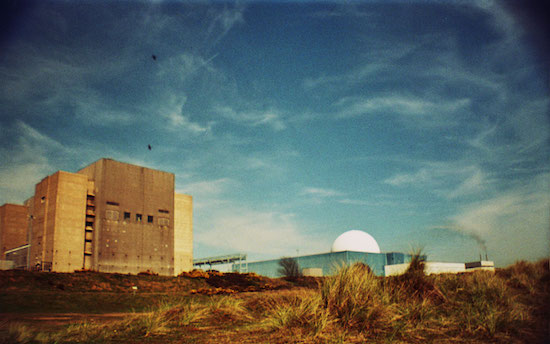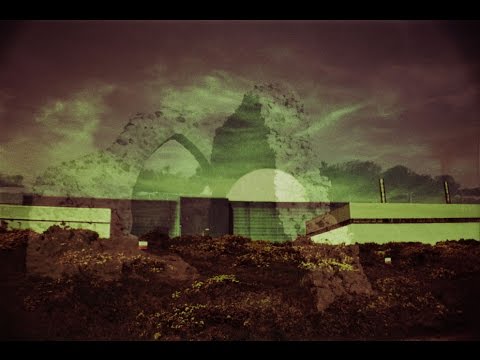Filmmmaker, academic and writer Adam Scovell recently released a new short of footage shot around the Sizewell B nuclear power station on the Suffolk coast. You can watch the film, soundtracked by original music by long-time Quietus favourite Richard Skelton above, and read some words by Scovell on the project below:
"The contours of the Sizewell power plant, its Magnox block a glowering mausoleum, begin to loom upon an island far out in the pallid waters where one believes the Dogger Bank to be, where once shoals of herring spawned and earlier still, a long, long time ago, the delta of the Rhine flowed out into the sea and where green forests grew from silting sands." – W.G. Sebald (1995).
Last year I was lucky enough to be able to film some reels of super-8 footage all around the abandoned Orford Ness nuclear testing facility in Suffolk for an, as yet unrealised, film project. The trip to visit the area had been a strange, surreal journey but also one that spurred on several ideas for future films all about this particularly palimpsestic piece of East Anglian coastline. After the filming, I was dropped off much further along the coast in the town of Dunwich and proceeded to walk back down towards its famously beautiful heath and eventually Minsmere RSPB Reserve. It was when sat at a bench upon the heath, accompanied only by the occasional lizard and tiger beetle, that I saw Sizewell nuclear power station properly for the first time and was totally awestruck by it. The dome of Sizewell B in particular seemed to encapsulate so much current visual interest – a mixture of hauntological catastrophe, Nigel Kneale-esque conspiracy and even Richard Mabeyian Unofficial Countryside – that I promised myself to return and make a film about it. Heavy Water is the finished result.
Taking the walk from Sizewell itself back to Dunwich conjures many strange images and ghosts but these spectres are largely dominated by the writer, W.G. Sebald, whose work had already inspired the original Suffolk trip to Orford. The stretch of coast plays a huge and forbidding role in his novel, The Rings Of Saturn (1995), and it wasn’t difficult to get into the mindset of Sebaldian topographical time-slips; where the possible calamity of a nuclear fallout at the plant seemed to be already pre-empted by the so-called "flight of Dunwich" as Sebald calls it. Dunwich could have been one of the biggest cities in the UK, with its successful port developing right up into the 1200s before a succession of storms dragged the land under the waves and turned the potential port-city into the tiny country village that it still is today. The two areas, which are virtually adjacent to each other, barring the aforementioned RSPB reserve, have a strange dialectic that can’t help but arise when walking between them as two points because of the unavoidable transience of the very soil and shingle underfoot.
Walking on the day recalled many creative works based around the coastline. M.R. James especially came to mind as the beach of Dunwich is so clearly the inspiration for his chilling story, Oh, Whistle, And I’ll Come To You M’Lad (1904); both place and story contain a Knights Templar burial ground as well as the repressed ghosts of lost towns and minds. Though Jonathan Miller would look to further north over the border to Waxham in Norfolk when adapting the story for the BBC’s Omnibus in 1968, Miller’s studio pieces are clearly also indebted to the same crumbling coastline which has his character uncover the bones of the dead and the dangerously cursed whistle from the graves opened by the receding of the cliffs. On the walk, a strange totem was also present further down from Dunwich just before Minsmere, implying such esoteric and ritualistic relationships with the land to still be sprouting even today. A few casual silhouettes cast further down the beach caused several occasions to look back with a slight but excitedly Jamesian nervousness. When finally approaching Dunwich’s own shingle towards the conclusion of the filming, Brian Eno’s own reflection on the area, Dunwich Beach, Autumn, 1960, seemed to be carried within the soil and stones too. Richard Skelton’s wonderful score for this film finds far more menace than Eno’s gentle evocation but both earnestly tap into the place’s strong sense of otherness.
Yet, even with these ghosts wandering and meandering around the paths, it is Sebald’s work which ultimately still haunts this coastline. Reading The Rings Of Saturn augments this stretch of shingle, marram grass, heath, concrete and wood, earnestly changing it into something more wearied, perhaps a mixture of unheeded warnings and melancholic realisations. Heavy Water aims to capture some of that sense though knows deep down that Sebald’s own walk was its own unrepeatable moment of capture, a detailed memoranda of loss and unheimlich, amplified by a coastline that itself is built and harnessed on such elements; where walking becomes potentially both a temporal as well as a physical traversing. As Sebald writes when getting lost in the heathland, "Lost in the thoughts that went round in my head incessantly, and numbed by this crazed flowering, I stuck to the sandy path until to my astonishment, not to say horror, I found myself back again at the same tangled thicket from which I had emerged about an hour before, or, as it now seemed to me, in some distant past." (1995).



